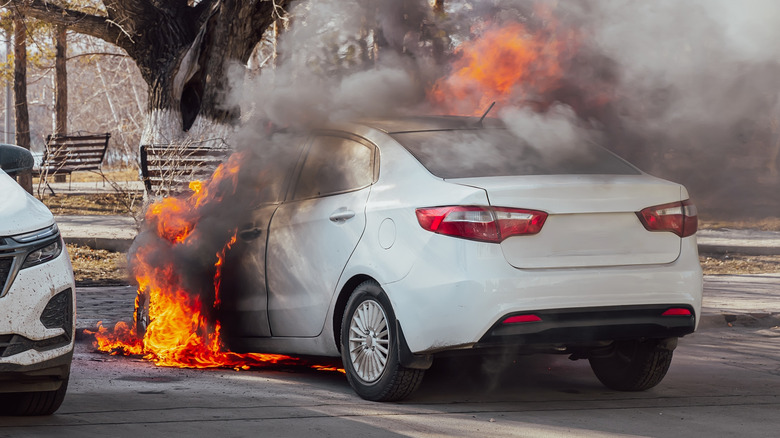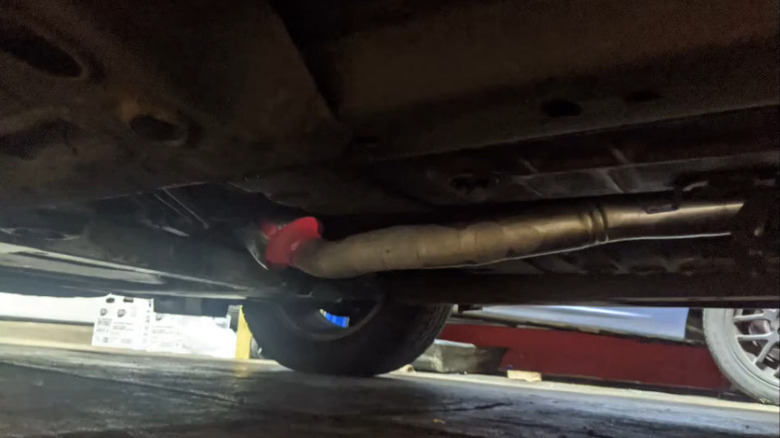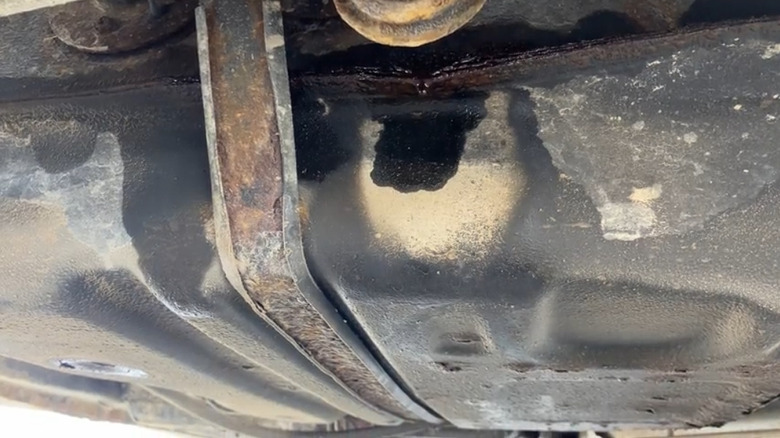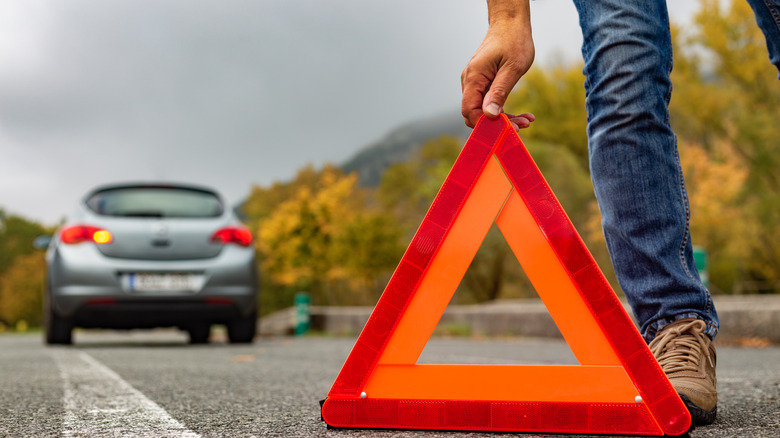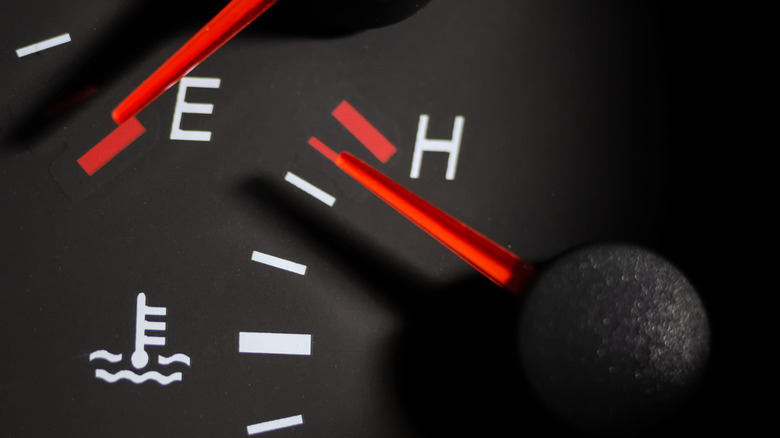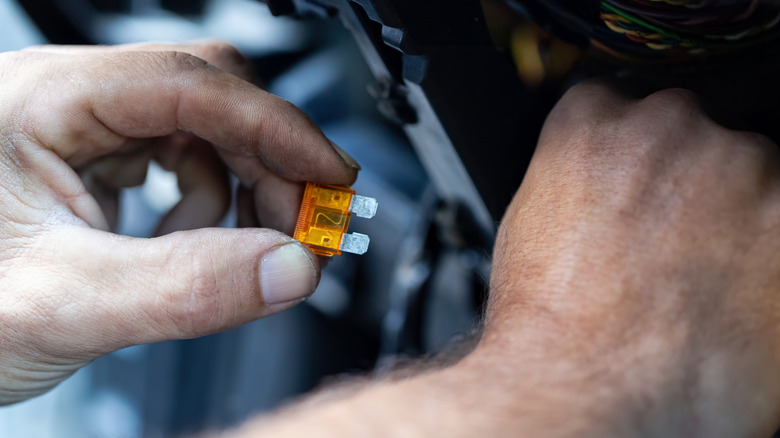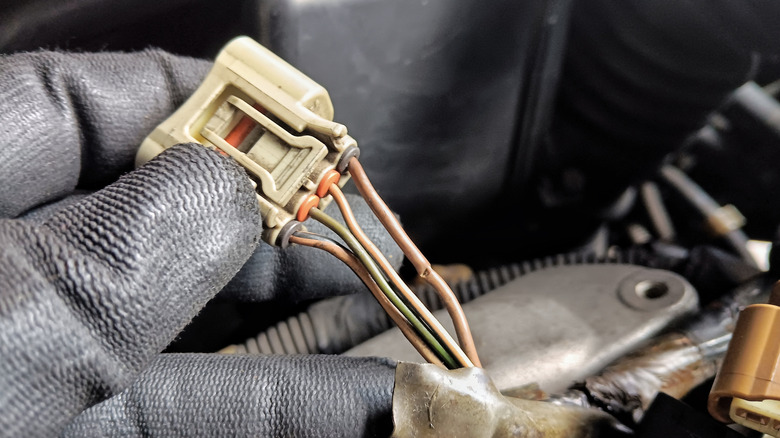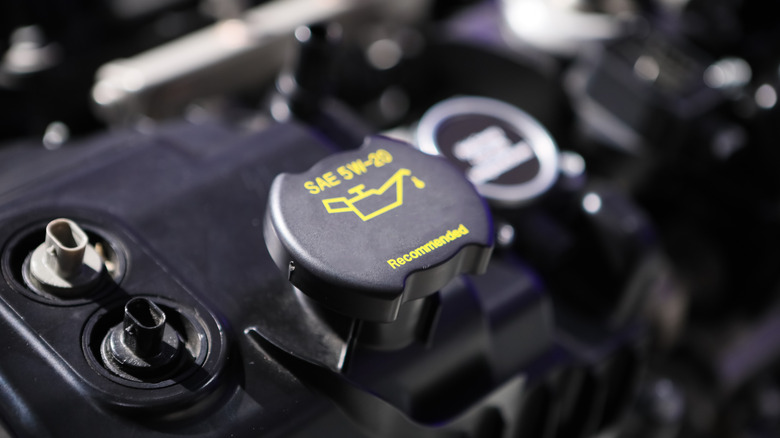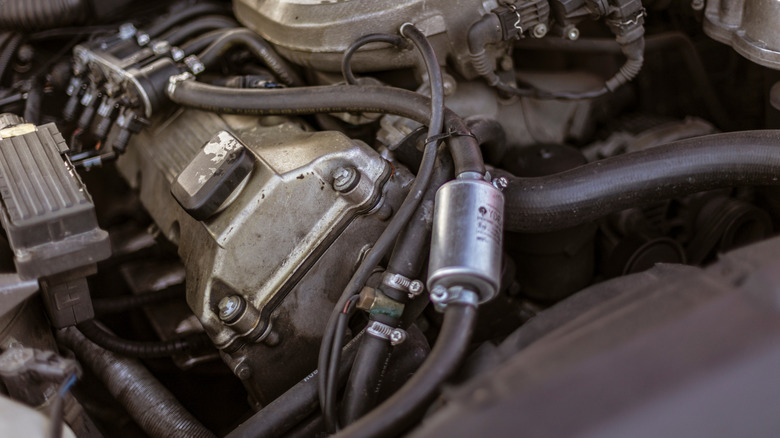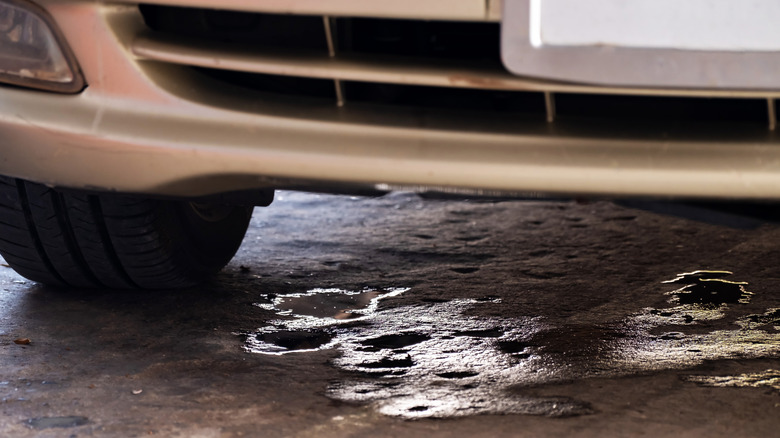13 Warning Signs Your Car May Be About To Catch Fire
Let's have a little heart-to-heart about your four-wheeled partner in crime. Sure, it's a marvel of engineering, but it's also a mobile cocktail of flammable liquids, hot metal, and moody electronics, all held together by hope and a few well-placed bolts. The thing is, when something goes wrong, your car won't send you a polite email (at least not yet). It'll communicate through smells, sounds, and dashboard drama. The problem? Most people brush off those warning signs as minor quirks until it's too late.
An odd plasticky smell? "Probably nothing." A weird gauge spike? "It'll fix itself." That fluid puddle in the driveway? "I'll deal with it later." And then later becomes never, and never becomes "Why is there smoke coming out of my vents?" But don't panic. Not every odd smell or flicker means your ride's about to become a full-on "car-becue." The key is separating the harmless chatter from the stone-cold threats. To keep you from starring in your own roadside drama, we've rounded up the top 13 signs that your car is seriously considering a fiery protest.
Burning smell
Ah yes, the universal "something is definitely wrong" indicator. A burning smell can mean a few different things, and none of them are good. If it's a greasy, oily kind of burn, that's the scent of flammable fluids dripping onto your hot engine, exhaust manifold, or catalytic converter. And considering those parts can reach over 1,000°F, you can see how a little drip can turn into a big fire really fast. If it's a more metallic, acrid smell, especially after some, ahem, spirited driving, that's likely your brakes or clutch throwing a superheated tantrum. "Can that really cause a fire?" you ask. Absolutely! That intense, focused heat can ignite leaking brake fluid or even the pads themselves if it gets bad enough.
And if it smells plasticky, fishy, or like burning chemicals? That's probably the electrical wiring insulation melting down. Wires run all through your car, and when they overheat or short out, the plastic coating starts to cook. It's a distinct, nasty smell that you definitely don't want to ignore, as electrical fires can spread fast. In fact, don't ignore any of these sassy scents. Your car isn't trying to set the mood — it's sending an SOS. So, pull over safely, turn off the engine, and let things cool. If the smell is strong or you see smoke, it's time to call for backup, not play hero. A little caution now beats a melted masterpiece later.
Rotten egg smell
When your car smells like a swamp monster's breakfast burrito, it's not the week-old leftovers rolling around under your seat (we hope). That sulfur stink (pure rotten-egg energy) is your catalytic converter's dramatic cry for help. Why? Your catalytic converter is a brilliant little box of chemistry meant to clean up your exhaust gases. But when your engine throws a little fit (think persistent misfires or fuel issues), raw gasoline crashes the party and ignites right inside the converter. This creates a meltdown of epic proportions, and the chemical reaction starts cooking up hydrogen sulfide gas, nature's very own rotten-egg perfume.
Now for the scary part: A struggling catalytic converter doesn't just smell bad, it runs dangerously hot. While a healthy converter operates around 1,200°F, a failing one can skyrocket well past 1,600°F. At those temperatures, it may glow red hot underneath your car. Any nearby leaves, grass, or leaking fluids could ignite in seconds, turning your peaceful drive into a roadside pyrotechnic show. The real drama starts when all that heat melts the converter's insides into a solid lump. Now your engine's trying to breathe through a clogged straw — wheezing, gasping, and going nowhere fast. Keep ignoring it, and you're just watching your engine die of exhaustion, one sad rev at a time.
Gasoline fumes
If you smell gasoline and you're not actively filling up your tank, that's a massive red flag. Like, pull-over-right-now level serious. Gas leaks are one of the top causes of car fires because liquid fuel plus a hot engine is a recipe for disaster. Your exhaust manifold and catalytic converter sit between 700°F and 1,600°F on a good day. Fire risk? Try fire guarantee.
But here's an even bigger problem: Leaking gasoline is so eager to party that it often doesn't even bother staying in liquid form. It evaporates into an invisible, flammable cloud of trouble just waiting for a reason (any reason) to go up in flames. And the wild part? It doesn't even need a spark. Gasoline vapors can auto-ignite at around 536°F, which means a concentrated cloud of fumes will happily burst into flames the second it touches a scorching-hot engine part.
There are plenty of ways gas can escape: worn fuel lines, sketchy connections, damaged tanks, or fuel injectors gone rogue. The frustrating thing is that small leaks often evaporate before leaving a trace. But your nose knows: That gasoline smell isn't subtle, and it's definitely not lying to you.
Visible smoke
If your car starts puffing smoke rings like a retired dragon at a cigar lounge, it's time to play everyone's least favorite game: "Where's That Smoke Coming From?!" The source of the smoke can tell you a bit about the trouble you're in. Let's start under the hood, because that's where things get spicy fast. The smoke could be from leaking oil or coolant sizzling on your scorching engine block. Or worse, it could be your electrical wiring having an absolute meltdown. Either way, you're just one small spark away from a five-alarm fire.
Smoke from your wheels? Most often, a brake caliper gets stuck and makes the pad cling to the rotor like it's never letting go. Sometimes it's a wheel bearing that's had enough of this whole "spinning" thing. Or maybe a tire's been dragging due to a locked brake. Once rubber starts to smolder, it doesn't take much to turn it into a full-blown tire fire. And let's not forget about the tailpipe. A little wisp of steam is no big deal, but constant smoke tells you something's wrong. Here, the color of the exhaust smoke matters: White smoke points to coolant issues, blue means oil's getting torched where it shouldn't, and black smoke? Your engine's guzzling way too much fuel, which can superheat your catalytic converter into a glowing fire hazard.
Excessive backfiring
A lot of people love those pops, crackles, and bangs on deceleration, especially when a few flames shoot out for dramatic effect. But there's a world of difference between a car that's been professionally tuned to "sing the song of its people," and your everyday commuter suddenly sounding like it's reenacting Fast & Furious: Exhaust Edition. If your car isn't tuned for it, those loud bangs are a serious cry for help. All that backfiring means your engine has failed to burn all its fuel properly, so raw gasoline ends up in your blisteringly hot exhaust system.
You can think of each pop as your engine lighting a firecracker inside the exhaust. It creates way more heat than the system can handle, potentially melting the ceramic honeycomb inside your catalytic converter into a solid brick. And what does a clogged converter do? It overheats to glowing-red, pizza-oven temperatures, threatening to ignite any nearby fluid, plastic, or dry grass. A gentle pop here or there? Classic. But when your tailpipe starts dropping beats like a drumline, you've crossed the line from "quirky" to "combustible."
Sudden loss of power or stalling
Look, cars lose power and stall for a million reasons. It happens. Sometimes it's just a fuel pump failing or a sensor being dramatic. And other times, you've got a legitimate crisis brewing, like a fuel leak starving your engine. But the real kicker? Even a "harmless" stall creates the perfect recipe for a fire. The second your engine dies, all cooling and circulation stop: The water pump? Off. The cooling fans? Off. And the rush of cool air you had at 60 MPH? Gone.
Let's say your car stalls due to something boring, like a broken sensor. No big deal, right? But you also have that "tiny" oil leak from your turbo. While you were driving, the 60-mph wind was your best friend, blowing that oil away before it could get into real trouble. But now, you're parked, and that oil's cooking on parts so hot it could catch fire any second. Oh, by the way, your catalytic converter runs at over 1,000°F and will stay that way for a while. You didn't happen to pull over onto dry grass, did you? Because you're about to start an unplanned wiener roast.
Rapid gauge changes
You know how your heart rate jumps when something's wrong? Same goes for your car. When those dashboard gauges start moving into the danger zone, your vehicle's trying to tell you it's in trouble. A temperature gauge spiking? Your engine's overheating, and that's an express train to disaster. Coolant can boil over and spray onto scorching engine parts. Gaskets and seals might start giving up, leaking even more combustible fluids onto surfaces already hot enough to cook on. It's a domino effect of bad news.
Voltage gauge doing the electric slide? Your alternator's probably on a power trip. Too much charge, and your car goes from "running hot" to "on fire." Fuel gauge dropping faster than your motivation on a Monday? You may have a serious leak. And leaking gasoline meeting hot engine components is about as dangerous as it gets. Sure, the drama might not always end in flames, but rapid gauge changes are your car's version of clutching its chest and gasping for help. Get it checked out before that dashboard panic turns into roadside chaos.
Dim or flickering lights
Your headlights are flickering, dimming, and generally acting possessed. Spooky ghosts? Eh, probably not. What's more likely is that your electrical system's voltage is going haywire, and that could be way more dangerous than any paranormal activity. The worst part? Your dashboard might not even tell you. Many cars don't have a handy voltage gauge to show what's up, so when your lights start flickering, that's your car's way of sounding the alarm.
Large voltage swings build heat fast, and the usual suspect is the alternator. When an alternator decides to clock out, it goes through a phase where it can't regulate voltage properly. One minute it's lazy (dim lights), the next it's pumping out way too much juice (bright, surging lights). This electrical drama is death to your wiring. It cooks components and can even stress out your poor battery so much that it starts venting flammable hydrogen gas (yep, hydrogen, the same stuff at the heart of the Hindenburg mystery). But hey, the alternator's not always to blame — faulty wiring can stir up the same chaos. Either way, those flickering lights are your cue to get things checked before your car becomes its own campfire.
Frequently blown fuses
If you find yourself replacing the same fuse over and over, that's not just bad luck with cheap fuses. Your car's probably trying to tell you something's seriously wrong with its electrical system. Fuses exist for one reason: to blow before something worse happens. They're the sacrificial lambs of your car's wiring, designed to fail when too much current flows through a circuit.
A blown fuse happens for a reason, and that reason is almost always a short circuit. A short is what happens when a wire loses its insulation and decides to make friends with nearby metal. The result? Arcing, sparks, and enough heat to melt plastic or set something smoldering.
Aftermarket electronics love causing trouble, too. An improperly wired amplifier or cheap phone-charging cable can overwhelm circuits and turn your dash into a fire hazard quicker than you'd believe possible. Whatever the cause, that problematic fuse is your last line of defense. If you just keep replacing it (or worse, put in a bigger one), you're not fixing the problem — you're just resetting the timer on an electrical fire.
Damaged wiring
If you pop the hood and see wires that look like their little plastic jackets are cracked, missing, or melted ... Congrats. This is a clear-as-day, grade-A fire hazard. Now, maybe it hasn't blown a fuse or made your lights flicker yet. Yay, you! You've caught the issue early. Go buy a lottery ticket, you lucky detective. But let's not push your luck by actually starting the car.
The bad news is, you're still staring at one of the most common causes of automotive electrical fires. Damaged wiring is a ticking time bomb. When insulation wears away, bare wire can touch metal and spark like a mini lightning bolt, creating serious heat in seconds. If it's near fuel lines, brake lines, or anything flammable, you've got yourself a front-row seat to a potential disaster. Melted connectors are equally sketchy. If the plastic's warped, something already got hot enough to start melting. It might still work for now, but it's only a matter of time before it fails completely (and maybe takes the rest of your beloved ride with it).
Missing oil cap
A missing oil cap? That's almost too simple to be dangerous, right? It's just a little cap. What's the worst that could happen? Well, turns out a missing or loose oil cap is a surprisingly effective way to turn your engine bay into a fire hazard.
Why? Your engine's crankcase builds up pressure as it runs. That pressure needs somewhere to go, and normally, the oil cap keeps everything sealed up tight while the ventilation system handles the excess pressure properly. But when that cap's missing or loose, all that pressure shoots straight up through the open oil filler hole, coating the hottest parts of your engine in a fine, flammable mist.
The worst part? You probably won't notice right away. The cap might've been left off after an oil change or worked itself loose over time. Meanwhile, your engine's out there flinging oil onto anything hot enough to ignite. So yeah, regularly check your oil cap. Make sure it's there and tight, especially after an oil change. It's a five-second check that could save you from explaining how a three-dollar cap cost you an entire car.
Worn or loose hoses
Your car's got hoses everywhere — fuel lines, coolant hoses, oil lines, brake lines — and they're all basically just rubber tubes doing their best to contain liquids that really don't want to be contained. The problem? Rubber doesn't last forever. Heat, pressure, and time all take their toll. Hoses crack, get brittle, and develop tiny leaks. Sometimes the clamps holding them loosen up, too, and they start weeping fluid from the connections.
The leak might start as just a small drip that burns off harmlessly. But as the leak gets worse — and it always gets worse — that "drip" turns into a "spray" the next time you hit a bump. Now, instead of a little sizzle, you've got a high-pressure stream of flammable oil, coolant, or even fuel aimed directly at your scorching-hot exhaust manifold.
Or, just as scary, that old rubber brake line finally springs a leak right as your caliper seizes up, spraying flammable brake fluid all over a glowing-hot brake rotor. Moral of the story? Hoses don't last forever, and "it's just a little leak" are famous last words. Check them, squeeze them, replace them — before your car decides to make its own special effects show.
Leaking fluid
If your car is "crying" a puddle onto your driveway, you need to know what kind of tears these are (hint: they're not tears of joy). First, let's rule out the obvious: A little puddle of clear water under the engine on a hot day? That's just condensation from your A/C. Totally normal. Anything else? Trouble brewing. That's because every automotive fluid is flammable under the right conditions. Coolant might be mostly water, but once that evaporates, its glycol base can burn. Oil? Yep, flammable, especially the old, heat-soaked kind. Gasoline? No explanation needed there. And brake, transmission, and power steering fluids will all ignite if they land on something hot enough.
But how are you supposed to tell what's leaking? Spoiler: Don't taste it. Let your eyes (and nose) do the work. Bright green, pink, or orange? Coolant. Red or amber? Probably transmission or power steering fluid. Dark brown or black? That's oil, and if it's rainbow-y on a rainy day, that's just a thin film of oil playing tricks with the light. Brake fluid usually looks clear to yellowish, but don't be fooled, it's flammable, slippery, and has a knack for finding hot rotors. And if your nose says gas? Congrats, you've got the most flammable option in the lineup.
